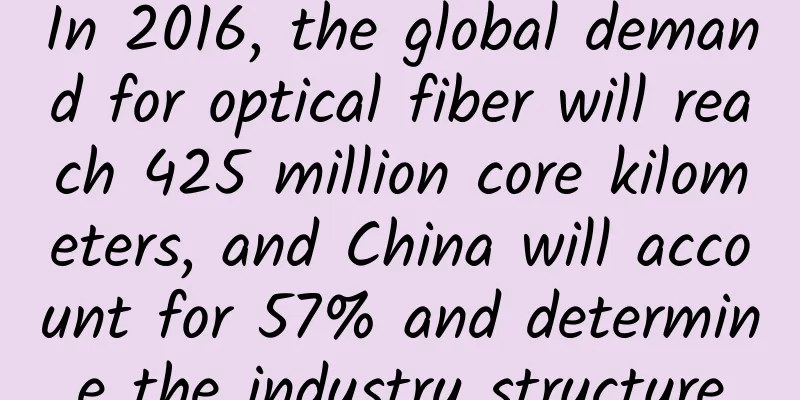In 2016, the global demand for optical fiber will reach 425 million core kilometers, and China will account for 57% and determine the industry structure

|
December 12 morning news (Jiang Junmu) The global demand for optical fiber and cable will reach 425 million core kilometers in 2016, of which China will account for 57%, predicted John Johnson, president of CRU China. At the 2017 Hengtong Group Media Interaction Conference on the 11th, Johnson delivered a keynote speech entitled "The Chinese Market Determines the Global Optical Fiber and Cable Industry Landscape", sharing CRU's view on the current status and future prospects of the global optical fiber and cable market, and particularly emphasized that "China accounts for the largest share of global optical fiber demand" and "as China's demand is higher than expected, global optical fiber and cable demand will hit a new high in 2016." The report said that the global demand for optical fiber and cable has exceeded 400 million core kilometers, and China's strong demand is still the main driving force, which will continue to lead the global growth trend. The demand in North America and the Asia-Pacific market outside China has maintained an upward trend; the demand growth in Western Europe has increased significantly, and the Eastern European market is also gradually recovering. At the same time, China's fiber optic deployment is developing at an extraordinary speed. Johnson compared it with the United States, saying that China's cumulative fiber optic installation volume is comparable to that of the United States, but in a very short time. With the widespread coverage of 4G and fiber-to-the-home, will China's fiber optic cable growth reach saturation? CRU believes not. From 2010 to 2015, the average annual growth rate of global Internet traffic reached 29%, which means that fiber optic cable as infrastructure will still be the focus of investment. The huge demand is one thing, but more importantly, China's cable manufacturing industry is also rising strongly. Chinese manufacturers are expanding their production capacity at an astonishing rate, and they are also maintaining an aggressive attitude in optical fiber preforms. Johnson pointed out that several large preforms will be put on the market in 2017, but before that, the shortage of preform supply will limit the growth of demand to a certain extent. Other highlights of the report include: active fiber-to-the-home deployment has stimulated demand for optical cables in many countries and regions; the tight supply has limited the rapid growth of demand to a certain extent; in the future, developing communications markets will attract more investment in optical fiber cables; and the demand for submarine cables will continue its strong upward trend. “The pace of upgrading has not stopped, and the decline is still far away. Industry experts once predicted that fiber-to-the-home would be the ‘end’ of fiber optics development; today we see 5G, the Internet of Things and a series of new technologies emerging - which means that high-density needs exist not only in home networks.” Johnson concluded. |
<<: Woman connected to WiFi and received a huge bill: Some WiFi is actually charged
Recommend
HostXen fully upgrades KVM, new users get 20 yuan for registration, monthly payment starts from 70 yuan for 6G memory in the United States/Japan/Hong Kong
HostXen sent the latest information, the platform...
Use Qt to create your own serial port debugging assistant
[[376484]] In my work, the thing I deal with most...
Private wireless networks provide secure solutions for digital transformation
When many businesses first installed wireless IoT...
China has been preparing for IPv6 for more than a decade, but why is IPv4 still the mainstream?
It is understood that IPv6 was first introduced i...
You won’t know how slow your phone is until you see it! A conscientious tool to dig deep into your phone
This tool, called SoloPi, is used to monitor the ...
Keda releases global perception trinocular camera | one device can do three things
In all kinds of safe and bright construction For ...
The Three Realms of Industrial Internet
The Industrial Internet platform is now very popu...
Sharktech: 1Gbps unlimited traffic server starting at $79/month, Los Angeles & Denver data centers, 60Gbps high defense
Sharktech has no special offers recently, but has...
Architecture design of MQTT messaging platform for 10 million-level Internet of Vehicles
Preface With the advancement of the new four tren...
HostYun: Los Angeles/Japan/Korea/Hong Kong VPS monthly payment starts from 15 yuan, KVM architecture, CN2 GIA and other lines
HostYun is a Chinese VPS hosting company founded ...
Zigbee, BLE and Bluetooth Mesh, how to choose the best solution?
In the world of IoT, wireless communication techn...
AI brings innovative value, Huawei says it is time for AI to enter data center infrastructure
On November 15, 2018, the 4th Data Center Infrast...
A multi-dimensional interpretation of the construction of my country's comprehensive network governance system
At present, in the ever-changing and complex inte...
Make your customers want you to be theirs with Riverbed Digital Experience Management
[51CTO.com original article] If you download a mo...
Linkerd Canary Deployment and A/B Testing
[[413903]] This guide shows you how to use Linker...









